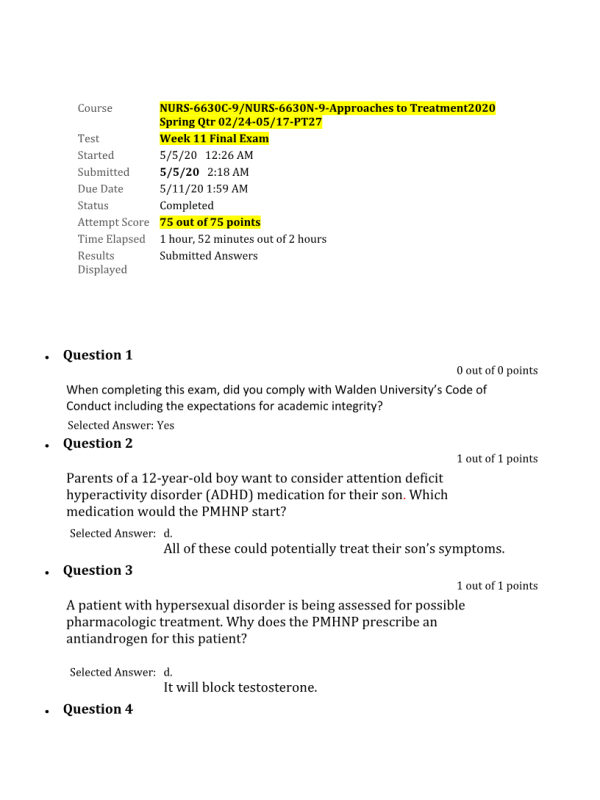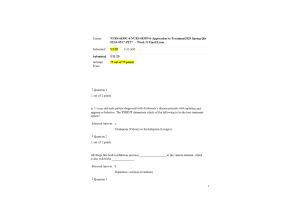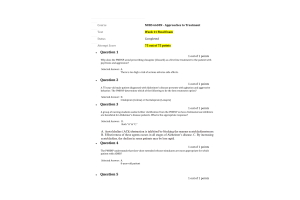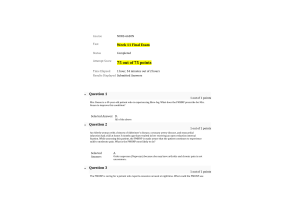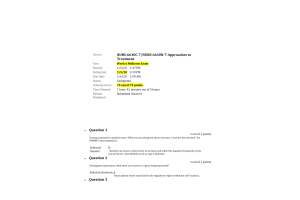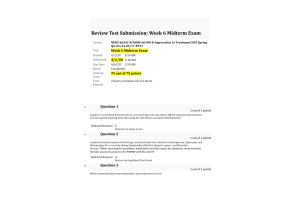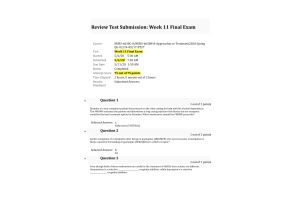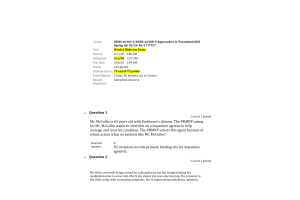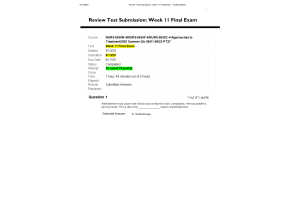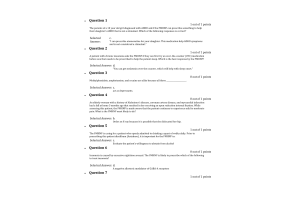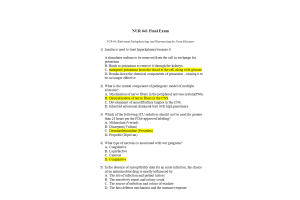NURS 6630C-9, NURS-6630N-9; Exam - Week 11 Final (75 out of 75 Points)
- $49.00
NURS 6630 - Psychopharmacologic Approaches to Treatment of Psychopathology
- Question: When completing this exam, did you comply with Walden University’s Code of Conduct including the expectations for academic integrity?
- Question: Parents of a 12-year-old boy want to consider attention deficit hyperactivity disorder (ADHD) medication for their son. Which medication would the PMHNP start?
- Question: A patient with hypersexual disorder is being assessed for possible pharmacologic treatment. Why does the PMHNP prescribe an antiandrogen for this patient?
- Question: Sandra complains of constipation after being on quetiapine (SEROQUEL) for several weeks. Constipation is likely caused by the binding of quetiapine (SEROQUEL) to which receptor?
- Question: The PMHNP understands that varenicline (CHANTIX) is an effective way to assist patients with smoking cessation. Why is this medication effective for these patients?
- Question: An 80-year-old female patient diagnosed with Stage II Alzheimer’s has a history of irritable bowel syndrome. Which cholinergic drug may be the best choice for treatment given the patient’s gastrointestinal problems?
- Question: Molly is a 52-year-old female that has a diagnosis of fibromyalgia. She complains of fatigue and cognitive difficulties. Which medication is the PMHNP most likely to prescribe?
- Question: A 71-year-old male patient comes to an appointment with his 65-year-old wife. They are both having concerns related to her memory and ability to recognize faces. The PMNHP is considering prescribing memantine (Namenda) based on the following symptoms:
- Question: A PMHNP supervisor is discussing with a nursing student how stimulants and noradrenergic agents assist with ADHD symptoms. What is the appropriate response?
- Question: The PMHNP is attempting to treat a patient’s chronic insomnia and wishes to start with an initial prescription that has a half-life of approximately 1–2 hours. What is the most appropriate prescription for the PMHNP to make?
- Question: The novel neurotransmitter adenosine is responsible for the sleep-wake cycle by increasing throughout the day and diminishing during night. Which of the follow is an antagonist of adenosine?
- Question: An 18-year-old female with a history of frequent headaches and a mood disorder is prescribed topiramate (Topamax), 25 mg by mouth daily. The PMHNP understands that this medication is effective in treating which condition(s) in this patient?
- Question: The PMHNP is selecting a medication treatment option for a patient who is exhibiting psychotic behaviors with poor impulse control and aggression. Of the available treatments, which can help temper some of the adverse effects or symptoms that are normally caused by D2 antagonism?
- Question: An adult patient presents with a history of substance-use disorder and attention deficit hyperactivity disorder (ADHD). Which of the following treatment options is best for this patient?
- Question: A patient is being prescribed bupropion and is concerned about the side effects. What will the PMHNP tell the patient regarding bupropion?
- Question: Which statement best describes a pharmacological approach to treating patients for impulsive aggression?
- Question: The PMHNP is caring for a patient with fibromyalgia. Which second-line treatment does the PMHNP select that may be effective for managing this patient’s pain?
- Question: The PMHNP is assessing a patient who presents with elevated levels of brain amyloid as noted by positron emission tomography (PET). What other factors will the PMHNP consider before prescribing medication for this patient, and what medication would the PMHNP want to avoid given these other factors?
- Question: The parents of a 7-year-old patient with ADHD are concerned about the effects of stimulants on their child. The parents prefer to start pharmacological treatment with a non-stimulant. Which medication will the PMHNP will most likely prescribe?
- Question: Insomnia is caused by excessive nighttime arousal. The PMHNP is likely to prescribe which of the following to treat insomnia?
- Question: Why does the PMHNP avoid prescribing clozapine (Clozaril) as a first-line treatment to the patient with psychosis and aggression?
- Question: Heather is admitted for opioid withdrawals and detoxification. The PMHNP decides to prescribe an alpha-2 adrenergic agonist to reduce the symptoms of autonomic hyperactivity during withdrawal and aid in the detoxification process. Which medication did the PMHNP prescribe?
- Question: A patient’s daughter calls your office with concerns that her mother is having significant gastrointestinal side effects. You review the patient’s chart and realize she is having side effects from donepezil (ARICEPT). What is the mechanism of the gastrointestinal disturbances?
- Question: A patient calls the clinic to ask about an over-the-counter sleep aid. What is the best response?
- Question: Naltrexone (Revia), an opioid antagonist, is a medication that is used for which of the following conditions?
- Question: Mrs. Kenner is concerned that her teenage daughter spends too much time on the Internet. She inquires about possible treatments for her daughter’s addiction. Which response by the PMHNP demonstrates understanding of pharmacologic approaches for compulsive disorders?
- Question: Which of the following substances has the highest probability of becoming dependent after a single use?
- Question: A 63-year-old patient presents with the following symptoms. The PMHNP determines which set of symptoms warrant prescribing a medication? Select the answer that is matched with an appropriate treatment.
- Question: The PMHNP is caring for a patient who experiences too much overstimulation and anxiety during daytime hours. The patient agrees to a pharmacological treatment but states, “I don’t want to feel sedated or drowsy from the medicine.” Which decision made by the PMHNP demonstrates proper knowledge of this patient’s symptoms and appropriate treatment options?
- Question: Karen completes the Epworth sleepiness scale and scores abnormally high. She is diagnosed with narcolepsy. The PMHNP prescribes a wake-promoting agent that is a weak dopamine transporter antagonist. Which medication did the PMHNP prescribe?
- Question: An elderly woman with a history of Alzheimer’s disease, coronary artery disease, and myocardial infarction had a fall at home 3 months ago that resulted in her receiving an open reduction internal fixation. While assessing this patient, the PMHNP is made aware that the patient continues to experience mild to moderate pain. What is the PMHNP most likely to do?
- Question: The parents of a 10 year old girl diagnosed with ADHD ask if the PMHNP can prescribe something to help their daughter’s ADHD that is not a stimulant. Which of the following responses is correct?
- Question: A patient with chronic insomnia asks the PMHNP if they can first try an over-the-counter (OTC) medication before one that needs to be prescribed to help the patient sleep. Which is the best response by the PMHNP?
- Question: A 72-year-old male patient is in the early stages of Alzheimer’s disease. The PMHNP determines that improving memory is a key consideration in selecting a medication. Which of the following would be an appropriate choice?
- Question: Harold complains of pain associated with his irritable bowel syndrome with constipation. The PMHNP decides to prescribe a medication that prevents pain signals from reaching the brain. Which agent does the PMHNP prescribe?
- Question: Jerry presents to the clinic for his four-week follow-up after starting trazodone for insomnia. How does trazodone help with insomnia?
- Question: Alcohol enhances inhibition at ____________ synapses and reduces excitation at ______________ synapses.
- Question: Antihistamines may cause side effects such as blurred vision, constipation, memory problems, and dry mouth. This is due to the _______________ effects of antihistamines.
- Question: Sharon is a 56-year-old female that presents to the clinic with pain after suffering a back injury several years ago. The patient states she feels a tingling sensation in her legs. What type of pain is Sharon likely experiencing?
- Question: A patient addicted to heroin is receiving treatment for detoxification. He begins to experience tachycardia, tremors, and diaphoresis. What medication will the PMHNP prescribe for this patient?
- Question: A nursing students asks the PMHNP the difference between impulsivity and compulsivity. Which of the following responses is correct?
- Question: Which patient will receive a lower dose of guanfacine?
- Question: The PMHNP is teaching a patient with a sleep disorder about taking diphenhydramine (Benadryl). The patient is concerned about the side effects of the drug. What can the PMHNP teach the patient about this treatment approach?
- Question: A patient presents with psychotic aggression. Which treatment option is best for a patient presenting with psychotic aggression due to impaired top-down cortical control and excessive drive from striatal hyperactivity?
- Question: Mrs. Rosen is a 49-year-old patient who is experiencing fibro-fog. What does the PMHNP prescribe for Mrs. Rosen to improve this condition?
- Question: A young patient is prescribed Vyvanse. During the follow-up appointment, which comment made by the patient makes the PMHNP think that the dosing is being done incorrectly?
- Question: The PMHNP wants to use a symptom-based approach to treating a patient with fibromyalgia. How does the PMHNP go about treating this patient?
- Question: A 26-year-old female patient with nicotine dependence and a history of anxiety presents with symptoms of attention deficit hyperactivity disorder (ADHD). Based on the assessment, what does the PMHNP consider?
- Question: A patient with chronic back pain has been prescribed a serotonin-norepinephrine reuptake inhibitor (SNRI). How does the PMHNP describe the action of SNRIs on the inhibition of pain to the patient?
- Question: The PMHNP understands that bupropion (Wellbutrin) is an effective way to assist patients with smoking cessation. Why is this medication effective for these patients?
- Question: Which of the following is considered as a disruptive/impulse control behavior?
- Question: Which of these characteristics does NOT meet the criteria for probably Alzheimer's dementia?
- Question: A group of nursing students seeks further clarification from the PMHNP on how cholinesterase inhibitors are beneficial for Alzheimer’s disease patients. What is the appropriate response?
- Question: A patient recovering from shingles presents with tenderness and sensitivity to the upper back. He states it is bothersome to put a shirt on most days. This patient has end stage renal disease (ESRD) and is scheduled to have hemodialysis tomorrow but states that he does not know how he can lie in a recliner for 3 hours feeling this uncomfortable. What will be the PMHNP’s priority?
- Question: Daniel is a 33 year old patient with ADHD and multiple comorbidities: mood disorder, alcohol abuse, ADHD, and nicotine dependence. Which comorbidity should be treated first?
- Question: The PMHNP prescribes gabapentin (Neurontin) for a patient’s chronic pain. How does the PMHNP anticipate the drug to work?
- Question: A nursing student asks the PMHNP about the difference between the use of stimulants in the treatment of ADHD and the abuse of stimulants in substance-use disorders. Which is the correct response?
- Question: A patient is prescribed D-methylphenidate, 10-mg extended-release capsules. What should the PMHNP include when discussing the side effects with the patient?
- Question: What will the PMHNP most likely prescribe to a patient with psychotic aggression who needs to manage the top-down cortical control and the excessive drive from striatal hyperactivity?
- Question: Individuals who suffer from an addiction often increase the dose of medication to achieve the desired effect. The need to increase the dose to reach the safe effect is due to __________________.
- Question: The PMHNP is assessing a 49-year-old male with a history of depression, post-traumatic stress disorder (PTSD), alcoholism with malnutrition, diabetes mellitus type 2, and hypertension. His physical assessment is unremarkable with the exception of peripheral edema bilaterally to his lower extremities and a chief complaint of pain with numbness and tingling to each leg 5/10. The PMHNP starts this patient on a low dose of doxepin (Sinequan). What is the next action that must be taken by the PMHNP?
- Question: Which of the following is a true statement regarding the use of stimulants to treat attention deficit hyperactivity disorder (ADHD)?
- Question: The PMHNP prescribed a patient lamotrigine (Lamictal), 25 mg by mouth daily, for nerve pain 6 months ago. The patient suddenly presents to the office with the complaint that the medication is no longer working and complains of increased pain. What action will the PMHNP most likely take?
- Question: The PMHNP is caring for a patient who openly admitted to drinking a quart of vodka daily. Prior to prescribing this patient disulfiram (Antabuse), it is important for the PMHNP to:
- Question: A 43-year-old male patient is seeking clarification about treating attention deficit hyperactivity disorder (ADHD) in adults and how it differs from treating children, since his son is on medication to treat ADHD. The PMHNP conveys a major difference is which of the following?
- Question: The PMHNP is performing a quality assurance peer review of the chart of another PMHNP. Upon review, the PMHNP reviews the chart of an older adult patient in long-term care facility who has chronic insomnia. The chart indicates that the patient has been receiving hypnotics on a nightly basis. What does the PMHNP find problematic about this documentation?
- Question: The PMHNP is treating a patient for fibromyalgia and is considering prescribing milnacipran (Savella). When prescribing this medication, which action is the PMHNP likely to choose?
- Question: A 75-year-old male patient diagnosed with Alzheimer’s disease presents with agitation and aggressive behavior. The PMHNP determines which of the following to be the best treatment option?
- Question: A patient with fibromyalgia and major depression needs to be treated for symptoms of pain. Which is the PMHNP most likely to prescribe for this patient?
- Question: The PMHNP is assessing a patient who will be receiving phentermine (Adipex-P)/topiramate (Topamax) (Qsymia). Which of the following conditions/diseases will require further evaluation before this medication can be prescribed?
- Question: You decide to start a patient on lurasidone (LATUDA). Which of these counseling points is correct?
- Question: Which of the following anticonvulsants increases serotonergic neurotransmission and GABAergic transmission, while decreasing glutamatergic neurotransmission?
- Question: All drugs that lead to addiction increase __________________in the ventral striatum, which is also called the _______________.
- Question: A patient with gambling disorder and no other psychiatric comorbidities is being treated with pharmacological agents. Which drug is the PMHNP most likely to prescribe?
- Question: The nursing staff asks the PMHNP for additional education regarding the treatment of agitation in dementia patients. Which of the following is correct?
- Question: A patient with chronic insomnia and depression is taking trazodone (Oleptro) but complains of feeling drowsy during the day. What can the PMHNP do to reduce the drug’s daytime sedating effects?
